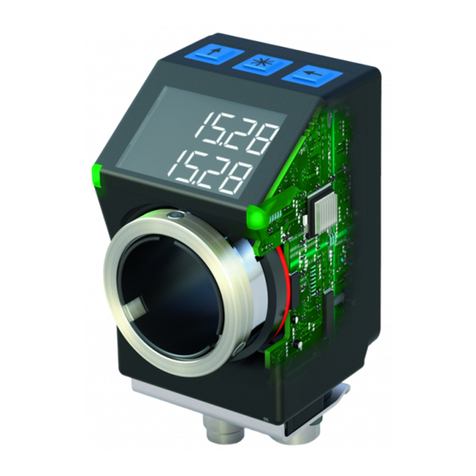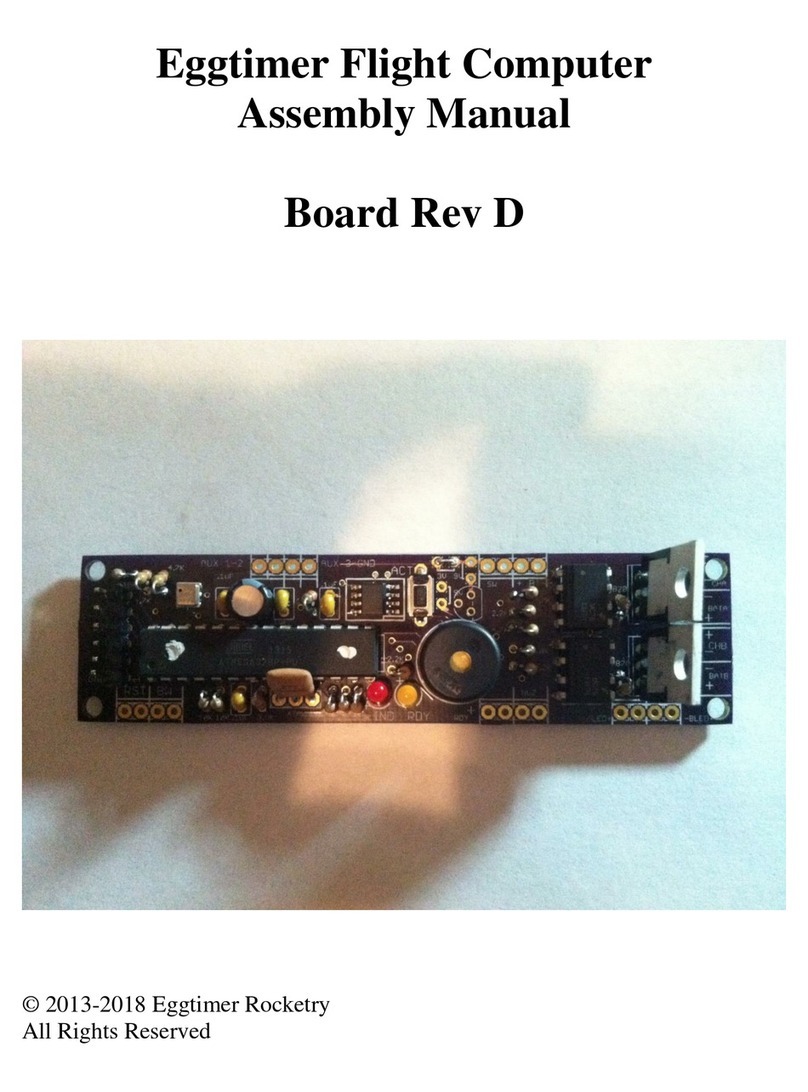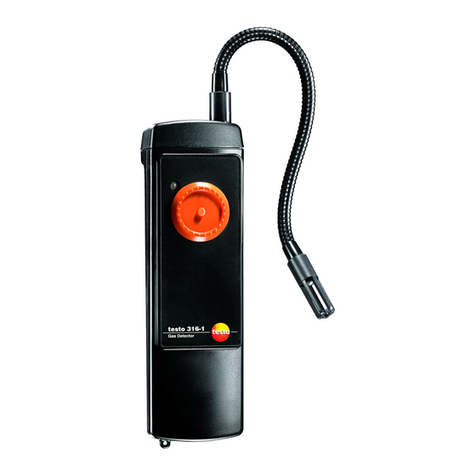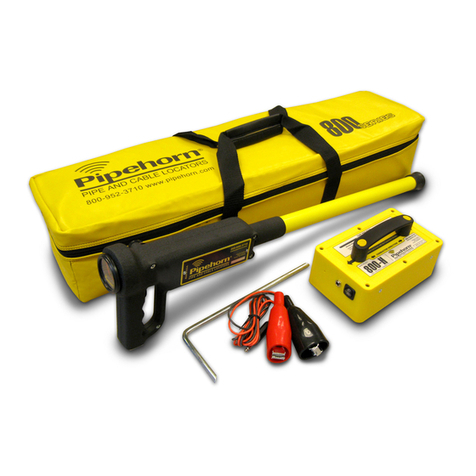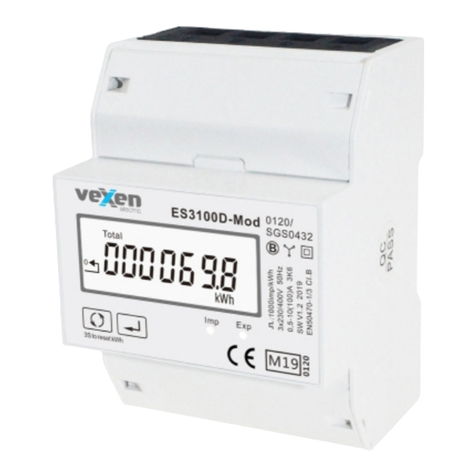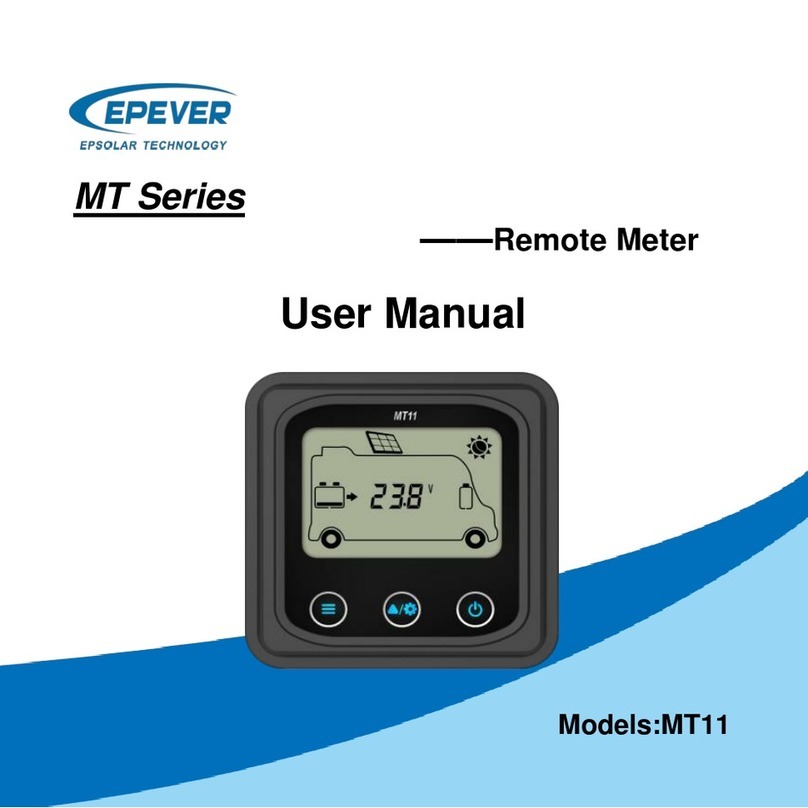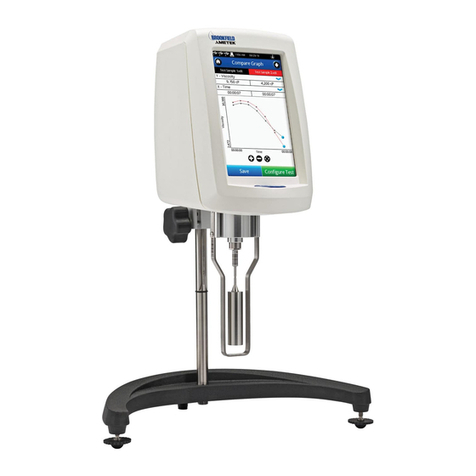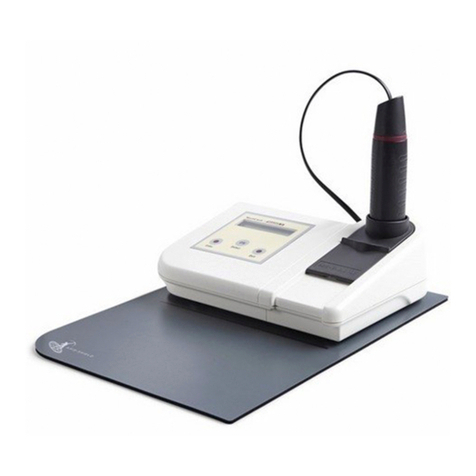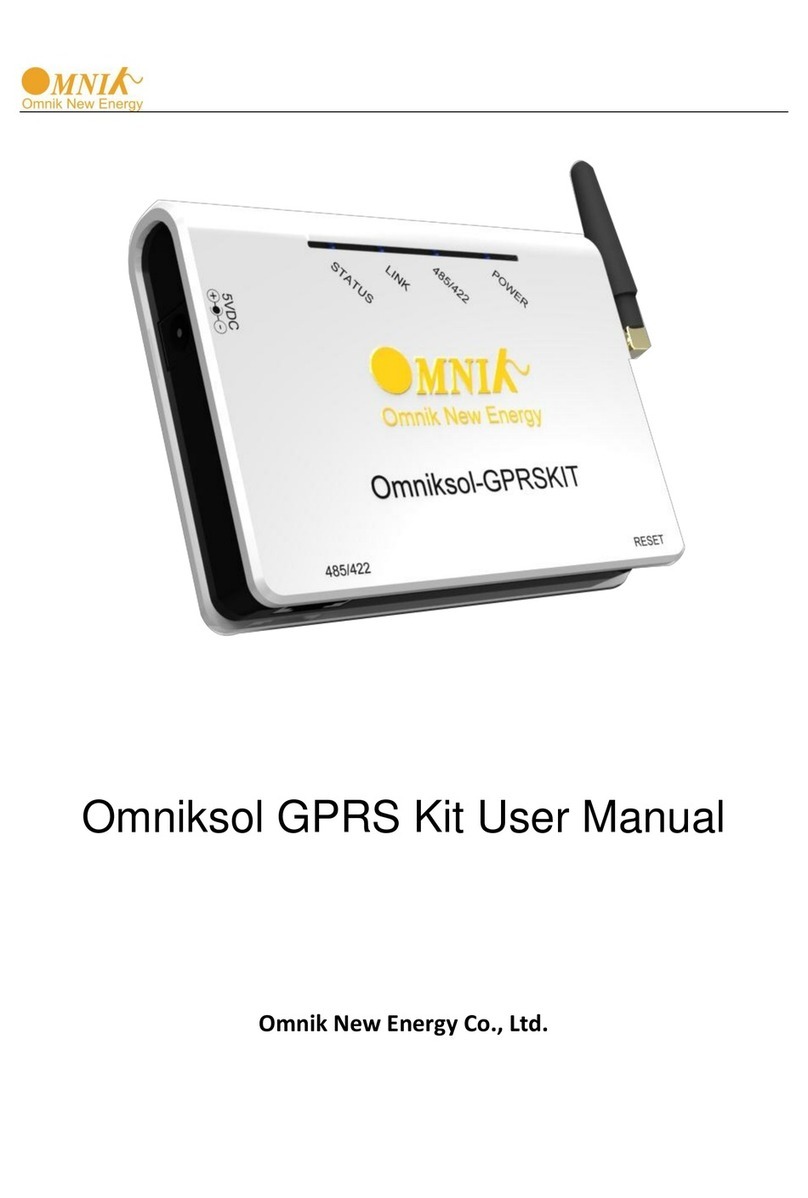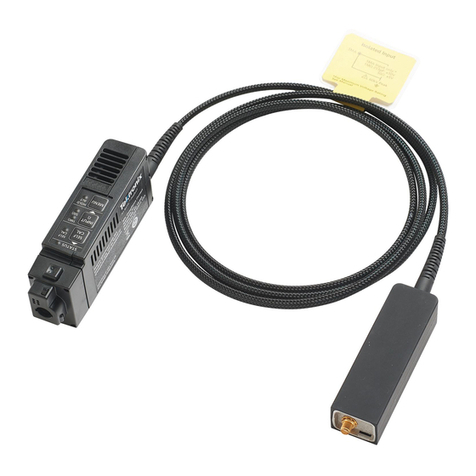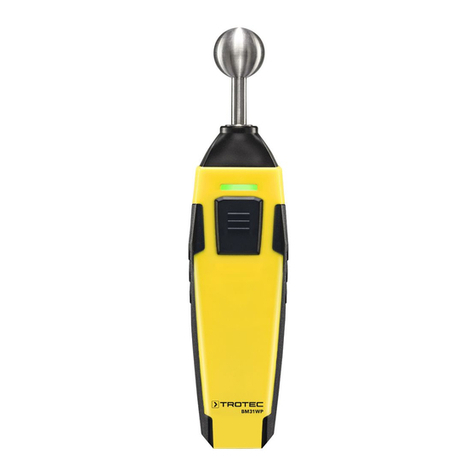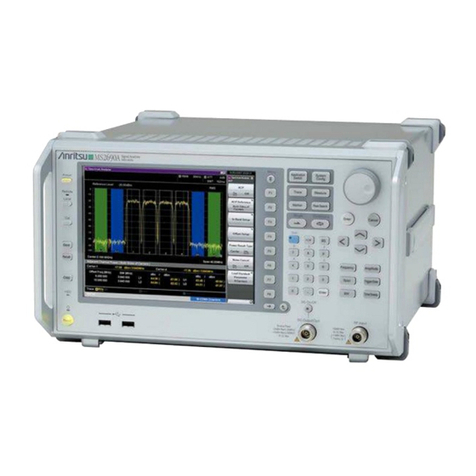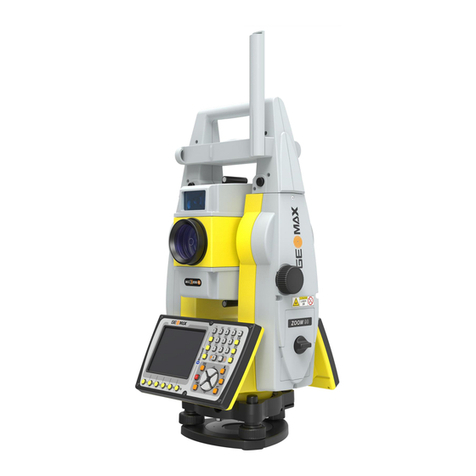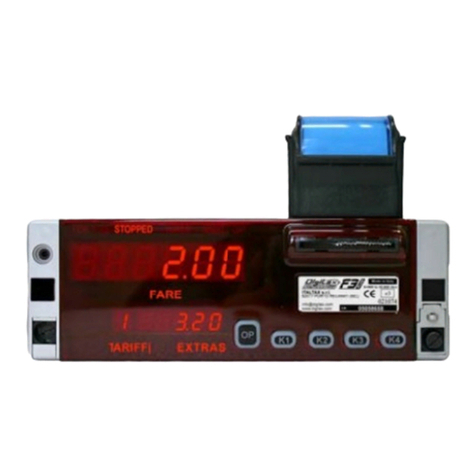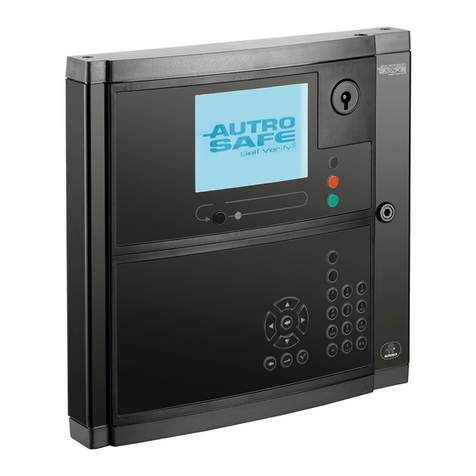GLI International C53 Instruction Manual

Rev. 5-1000 Model C53 Conductivity Analyzer (universal-mount 1/2 DIN)
1
OPERATING INSTRUCTION MANUAL
Model C53
Conductivity Analyzer
(Universal-mount 1/2 DIN style;
selectable for conductivity, resistivity, TDS,
and calculated Sensor A and B measurement)
Worldwide Headquarters and Sales:
GLI International, Inc.
9020 West Dean Road
Milwaukee, Wisconsin 53224
U.S.A.
Represented By:
In the interest of improving and updating its equipment, GLI reserves the right to alter specifications to equipment at any time.
A company
Viridor Instrumentation
Phone:
Fax:
E-mail:
Web:
[414] 355-3601
[414] 355-8346
info@gliint.com
www.gliint.com

Model C53 Conductivity Analyzer (universal-mount 1/2 DIN) Rev. 5-1000
2

Rev. 5-1000 Model C53 Conductivity Analyzer (universal-mount 1/2 DIN)
3
IMPORTANT SAFETY INFORMATION
This analyzer is compliant with safety standards as outlined in:
FMRC Class Numbers 3600, 3611, and 3810 (U.S.A.)
CSA C22.2 No. 142 and C22.2 No. 213 (Canada)
EN 61010-1 (European Community)
Please read and observe the following:
•Opening the analyzer door exposes you to line power voltage, if present, at terminals on TB2 and TB3
inside the enclosure. This may be hazardous. Always remove line power before entering this area in
the analyzer. However, the analyzer door assembly contains only low voltage and is completely safe
to handle.
•Wiring or repairs should only be performed by qualified personnel and only to an unpowered analyzer.
•Whenever it appears that analyzer safety is questionable, disable the analyzer to ensure against any
unintended operation. For example, an unsafe condition is likely when:
1) The analyzer appears visibly damaged.
2) The analyzer fails to operate properly or provide the intended measurements.
3) The analyzer has been stored for long periods at temperatures above 158°F (70°C).
•This analyzer must be installed by specially trained personnel in accordance with relevant local codes
and instructions contained in this operating instruction manual. Observe the analyzer’s technical
specifications and input ratings. If one line of the line power mains is not neutral, use a double-pole
mains switch to disconnect the analyzer.
HELPFUL IDENTIFIERS
In addition to information on installation and operation, this instruction manual may contain
WARNINGS pertaining to user safety, CAUTIONS regarding possible instrument malfunction, and
NOTES on important, useful operating guidelines.
WARNING:
A WARNING LOOKS LIKE THIS. IT WARNS YOU OF THE POTENTIAL
FOR PERSONAL INJURY.
CAUTION:
A CAUTION LOOKS LIKE THIS. IT ALERTS YOU TO POSSIBLE
INSTRUMENT MALFUNCTION OR DAMAGE.
☞
NOTE: A note looks like this. It alerts you to important, useful operating
information.

Model C53 Conductivity Analyzer (universal-mount 1/2 DIN) Rev. 5-1000
4
Definition of Equipment Symbols
This symbol means CAUTION and alerts you to possible danger or
instrument malfunction. Refer to this manual before proceeding.
This symbol means that this is a protective ground terminal and
alerts you to connect an earth ground to it.
This symbol means that there is alternating current present and
alerts you to be careful.
WARRANTY
GLI International, Inc. warrants the Model C53 to be free from defects in material
or workmanship for a period of 2 years (24 months) from the date of shipment of
this product from our facility. A warranty claim will not be honored if defects are
not reported within the warranty period, or if GLI International determines that
defects or damages are due to normal wear, misapplication, lack of mainte-
nance, abuse, improper installation, alteration, or abnormal conditions. GLI
International’s obligation under this warranty shall be limited to, at its option, re-
placement or repair of this product. The product must be returned to GLI
International, freight prepaid, for examination. The product must be thoroughly
cleaned and any process chemicals removed before it will be accepted for re-
placement or repair. GLI International’s liability shall not exceed the cost of the
product. Under no circumstances will GLI International be liable for any inciden-
tal or consequential damages, whether to person or property. GLI International
will not be liable for any other loss, damage or expense of any kind, including
loss of profits, resulting from the installation, use, or inability to use this product.

Rev. 5-1000 Model C53 Conductivity Analyzer (universal-mount 1/2 DIN)
5
CONDENSED OPERATING INSTRUCTIONS
This manual contains details for all operating aspects of the instrument. The following condensed in-
structions are provided to assist you in getting the instrument started up and operating as quickly as
possible. These condensed instructions only pertain to basic conductivity measurement opera-
tion. To measure resistivity, TDS or a calculated Sensor A and B measurement, or to use specific
features of the instrument, refer to the appropriate sections in this manual for instructions.
A. CONNECTING SENSOR(S)/CONFIGURING TEMPERATURE ELEMENT(S)
1. After properly mounting the analyzer (PART TWO, Section 2), connect the GLI enhanced per-
formance contacting conductivity sensor(s), matching wire colors to terminals as indicated:
Sensor A
Wire Colors Analyzers with
“B”Prefix Serial No.
Analyzers with
“A”or No Letter
Prefix Serial No.
Clear w/black
(
outer shield
)
Grounding strip lug Terminal #17 on TB1
Blue Terminal #18 on TB1 Terminal #18 on TB1
White Terminal #19 on TB1 Terminal #19 on TB1
Clear (inner shield wire) Terminal #20 on TB1 Terminal #20 on TB1
Black Terminal #21 on TB1 Terminal #21 on TB1
Red Terminal #22 on TB1 Terminal #22 on TB1
Sensor B
Wire Colors Analyzers with
“B”Prefix Serial No.
Analyzers with
“A”or No Letter
Prefix Serial No.
Clear w/black
(
outer shield
)
Grounding strip lug Terminal #11 on TB1
Blue Terminal #12 on TB1 Terminal #12 on TB1
White Terminal #13 on TB1 Terminal #13 on TB1
Clear (inner shield wire) Terminal #14 on TB1 Terminal #14 on TB1
Black Terminal #15 on TB1 Terminal #15 on TB1
Red Terminal #16 on TB1 Terminal #16 on TB1
2. The analyzer is factory-set for use with the Pt 1000 ohm temperature element built into GLI en-
hanced performance contacting conductivity sensors. When using a sensor brand with a different
temperature element, or for fixed MANUAL temperature compensation, you must change the
temperature element type (see PART THREE, Section 4.2, subheading “Select TEMP
ELEMENT Type”).
B. CONNECTING LINE POWER
Important: Follow the instructions in PART TWO, Section 3.5 to connect line power to the analyzer.
C. ADJUSTING DISPLAY CONTRAST
Ambient lighting conditions may make it necessary to adjust display contrast to improve visibility.
With the MEASURE screen displayed, press and hold the ENTER key and simultaneously press the
×
×
or
Ø
Ø
key until attaining the desired contrast.
D. CALIBRATING THE ANALYZER
The analyzer must be calibrated so that measured values will correspond to actual process values. It
can be traditionally “wet”calibrated. However, since measured conductivity is greatly affected by
small changes in temperature, GLI strongly recommends using its DRY-CAL method for highest
measuring accuracy of conductivity and temperature. Besides, DRY-CAL is actually a normal part of

Model C53 Conductivity Analyzer (universal-mount 1/2 DIN) Rev. 5-1000
6
CONDENSED OPERATING INSTRUCTIONS
D. CALIBRATING THE ANALYZER -- (continued)
configuring the sensor characteristics during initial startup, and DRY-CAL eliminates the need for
conductivity reference solutions. This method also automatically sets the analyzer measuring
range to match the inherent range of the sensor’s cell constant. For more details about the benefits
of DRY-CAL, refer to the “Calibration Tip!”in PART THREE, Section 5.1.
NOTE: DRY-CAL eliminates the need for periodic re-calibration! The only requirement, depending
on the application, may be to periodically clean the sensor. Only when the sensor is re-
placed is it necessary to perform a new DRY-CAL calibration.
Calibration Tip! Each contacting conductivity sensor has a unique zero point and offset. Conse-
quently, when calibrating a sensor for the first time, always zero it according to step 1. Zeroing
provides the best possible measuring accuracy, and eliminates any discrepancy between Sensor A
and B measurement channels.
DRY-CAL calibration, routinely attained while configuring the analyzer for sensor characteristics, re-
quires entry of the sensor’s GLI-certified “CELL K”value and temperature “T FACTOR”which are
unique to each sensor. When using two sensors, enter each unique set of values using respective
sensor menu screens.
1. Zero the sensor if it is being calibrated for the first time. If not, disregard this step and perform
steps 2 through 14.
Zeroing Tip! If at any time during zeroing, the “ZERO: CONFIRM FAILURE?”screen appears,
press ENTER key to confirm. Then, use the
×
×
or
Ø
Ø
key to select between “CAL: EXIT”or
“CAL: REPEAT”and do one of the following:
•With the “ZERO? (CAL: EXIT)”screen selected, press ENTER key. After the “ZERO:
CONFIRM ACTIVE?”screen appears, press ENTER key to return the analog outputs and
relays to their active states (MEASURE screen appears).
•With the “ZERO?: (CAL: REPEAT)”screen selected, press ENTER key to repeat zeroing.
A. Make sure that the sensor is dry before zeroing.
B. Press MENU key to display
&21),*85(
7(670$,17
(;,7
.
C. With the “CALIBRATE”line selected, press ENTER key to display
6(1625 %
2873876
(;,7
.
D. With the “SENSOR A”line selected, press ENTER key to display .
E. Use
Ø
Ø
key to select the “ZERO”line, and press ENTER key to display .
(continued on next page)

Rev. 5-1000 Model C53 Conductivity Analyzer (universal-mount 1/2 DIN)
7
CONDENSED OPERATING INSTRUCTIONS
D. CALIBRATING THE ANALYZER -- (continued)
F. Press ENTER key to “hold”the analog outputs and relays at their present states during ze-
roing. (Outputs can also be transferred to present values or allowed to remain active.)
G. With the “ZERO: IN DRY AIR?”screen displayed and the dry sensor held in air, press
ENTER key to start the automatic zeroing.
H. After the “ZERO: CONFIRM ZERO OK?”screen appears, press ENTER key to end zeroing.
I. After the “ZERO: CONFIRM ACTIVE?”screen appears, press ENTER key to return the
analog outputs and relays to their active states (MEASURE screen appears).
2. Press MENU key to display
&21),*85(
7(670$,17
(;,7
.
3. Use
Ø
Ø
key to select the “CONFIGURE”line, and press ENTER key to display
6(7 287387
6(7 5(/$< $
6(7 5(/$< %
6(7 5(/$< &
6(7 5(/$< '
6(7 3$66&2'(
6(7&25)
/$1*8$*(
6(1625 $
6(1625 %
&$/&8/$7,21
(;,7
.
4. Use
Ø
Ø
key to select the “SENSOR A”line, and press ENTER key to display
',63/$< )250$7
&203(16$7,21
&21),* &21'8&7
&21),* /,1($5
&(// &2167$17
6(7 ),/7(5
38/6( 68335(66
(17(5 127(
7(03 (/(0(17
(;,7
.
5. Use
Ø
Ø
key to select the “CELL CONSTANT”line, and press ENTER key to display .
6. With the “SELECT CELL K”line selected, press ENTER key to display a cell category selection
screen like . Use
Ø
Ø
and
×
×
keys to select the nominal cell category that cor-
responds to the sensor’s GLI-certified “CELL K”value shown on a label attached to its cable or to
the inside cover of its optional junction box. Then press ENTER key to enter the selection.
7. After the screen re-appears, use
Ø
Ø
key to select the “SET CELL K”line and
press ENTER key to display a “CELL K”value screen like . Adjust the dis-
played value to exactly match the sensor’s GLI-certified “CELL K”value. (Use
Ö
Ö
and
Õ
Õ
keys to
coarse adjust, and
×
×
and
Ø
Ø
keys to fine adjust.) Then press ENTER key to enter the value.
(continued on next page.)

Model C53 Conductivity Analyzer (universal-mount 1/2 DIN) Rev. 5-1000
8
CONDENSED OPERATING INSTRUCTIONS
D. CALIBRATING THE ANALYZER -- (continued)
8. After the screen re-appears, press ESC key once to display
',63/$< )250$7
&203(16$7,21
&21),* &21'8&7
&21),* /,1($5
&(// &2167$17
6(7 ),/7(5
38/6( 68335(66
(17(5 127(
7(03 (/(0(17
(;,7
.
9. Use
Ø
Ø
key to select the “TEMP ELEMENT”line, and press ENTER key to display
6(7 7 )$&725
6(7 0$18$/
(;,7
.
10. Use
Ø
Ø
key to select the “SET T FACTOR”line, and press ENTER key to display a “T FACTOR”
value screen like . Adjust the displayed value to exactly match the sensor’s
GLI-certified “T FACTOR.”(Use
Ö
Ö
and
Õ
Õ
keys to coarse adjust, and
×
×
and
Ø
Ø
keys to fine ad-
just.) Then press ENTER key to enter the value.
11. After the
6(7 7 )$&725
6(7 0$18$/
(;,7
screen re-appears, press MENU key once and then ESC key once
to display the MEASURE screen.
This completes GLI’s DRY-CAL calibration. The analyzer is now ready to measure conductivity.
To change the display format of the MEASURE screen (for example, from 0-2000 µS/cm to 0.000-2.000
mS/cm), refer to PART THREE, Section 4.2, subheading “Select DISPLAY FORMAT.”
NOTE: If the values you intend to measure are above the analyzer’s set measuring range (not its
selected display format), use a different sensor that has the appropriate nominal cell con-
stant. For a listing of sensor cell constants and their inherent measuring ranges, see Table A
in PART THREE, Section 4.2, subheading “Select DISPLAY FORMAT.”
E. COMPLETING ANALYZER CONFIGURATION
To further configure the analyzer to your application requirements, use the appropriate CONFIGURE
screens to make selections and “key in”values. Refer to PART THREE, Section 4 for complete con-
figuration details.

Rev. 5-1000 Model C53 Conductivity Analyzer (universal-mount 1/2 DIN)
9
TABLE OF CONTENTS
PART ONE - INTRODUCTION
SECTION 1 GENERAL INFORMATION
1.1 Capability Highlights ........................................................................15-17
1.2 Modular Construction ............................................................................17
1.3 Retained Configuration Values .............................................................17
1.4 Analyzer Serial Number ........................................................................17
1.5 EMI/RFI Immunity..................................................................................18
SECTION 2 SPECIFICATIONS....................................................................................19-20
PART TWO - INSTALLATION
SECTION 1 UNPACKING.................................................................................................21
SECTION 2 MECHANICAL REQUIREMENTS
2.1 Location.................................................................................................21
2.2 Mounting...........................................................................................21-23
2.3 Conduit Hole Requirements ..................................................................23
SECTION 3 ELECTRICAL CONNECTIONS
3.1 GLI Enhanced Performance Contacting Conductivity Sensor(s)......24-26
3.2 Analog Outputs......................................................................................27
3.3 Relay Outputs........................................................................................28
3.4 Closed Contact Input.............................................................................29
3.5 Line Power .......................................................................................29-30
PART THREE - OPERATION
SECTION 1 USER INTERFACE
1.1 Display .............................................................................................31-32
1.2 Keypad .............................................................................................32-33
1.3 MEASURE Screen (normal display mode).......................................33-34
SECTION 2 MENU STRUCTURE
2.1 Displaying Main Branch Selection Screen ............................................35
2.2 Displaying Top-level Menu Screens.................................................35-36
2.3 Displaying Submenu Screens ...............................................................36
2.4 Adjusting Edit/Selection Screen Values ................................................36
2.5 Entering (Storing) Edit/Selection Screen Values/Choices.....................36

Model C53 Conductivity Analyzer (universal-mount 1/2 DIN) Rev. 5-1000
10
TABLE OF CONTENTS (continued)
SECTION 3 DISPLAY CONTRAST VISIBILITY ...............................................................37
SECTION 4 ANALYZER CONFIGURATION
4.1 Selecting LANGUAGE to Operate Analyzer..........................................37
4.2 Configuring Sensor (A and B) Characteristics:
SELECT MEASURE (conductivity, resistivity or TDS) ................38-39
Select DISPLAY FORMAT..........................................................39-40
Select Temperature COMPENSATION............................................40
CONFIG TDS Measurement
(not needed for other measurements) ........................................41
CONFIG LINEAR Temperature Compensation
(not needed for other compensation methods)......................42-43
SELECT CELL K (sensor’s GLI-certified “K”value) .........................43
SET FILTER Time............................................................................44
Select PULSE SUPPRESS (on/off)..................................................44
ENTER NOTE (top line of MEASURE screen) ..................................45
Select TEMP ELEMENT Type ....................................................45-46
SET T FACTOR (sensor’s GLI-certified “T”factor) .....................47-48
4.3 Configuring Calculated Sensor A and B Measurement:
SELECT MEASURE (none, % rejection, % passage,
ratio A/B, ratio B/A, difference A-B or difference B-A) ................48
Select DISPLAY FORMAT (only for ratio A/B or ratio B/A;
not needed for other calculated measurements) ........................49
4.4 SET °C OR °F (temperature display format) .........................................49
4.5 Configuring Analog Outputs (1 and 2):
SET PARAMETER (representation) ...........................................50-51
SET 0/4 mA and 20 mA VALUES (range expand) ...........................51
SET TRANSFER Value (mA) ...........................................................52
SET FILTER Time............................................................................52
Select SCALE 0 mA/4 mA (low endpoint) ........................................53
4.6 Configuring Relays (A, B, C, and D):
SET PARAMETER (representation) ...........................................53-54
SET FUNCTION Mode (alarm, control or status)........................54-55
SET TRANSFER Mode (relay on or off) ..........................................55
ACTIVATION (configuration values) ...........................................56-57
4.7 SET PASSCODE (feature enabling or disabled)...................................58
4.8 Configuration Setting Summary (ranges/choices and defaults) .......59-61
SECTION 5 ANALYZER CALIBRATION
5.1 Things to Know About Calibration....................................................62-63
5.2 Zero Procedure (first-time sensor calibration only) ..........................63-64
5.3 DRY-CAL Method (highly recommended):
SELECT CELL K (sensor’s GLI-certified “K”value) ....................64-65
SET T FACTOR (sensor’s GLI-certified “T”factor) .....................65-67

Rev. 5-1000 Model C53 Conductivity Analyzer (universal-mount 1/2 DIN)
11
TABLE OF CONTENTS (continued)
5.4 1 POINT SAMPLE Method (wet calibration).....................................67-69
5.5 Analog Outputs (1 and 2) Calibration...............................................70-71
SECTION 6 TEST/MAINTENANCE
6.1 STATUS Checking (analyzer, sensors, and relays) .........................72-73
6.2 HOLD OUTPUTS ..................................................................................74
6.3 OVERFEED RESET (relay timers)...................................................74-75
6.4 OUTPUT (1 and 2) Analog Test Signals ...............................................75
6.5 RELAY (A, B, C, and D) Operating Test...........................................75-76
6.6 EPROM VERSION Checking ................................................................76
6.7 SELECT SIM Measurement ..................................................................77
6.8 SIM SENSOR Setting.......................................................................77-78
6.9 RESET DEFAULTS (configuration settings to factory-set values) .......78-79
SECTION 7 RELAY OVERFEED TIMER FEATURE
7.1 Why Use an Overfeed Timer.................................................................80
7.2 Configuring Relay Overfeed Timers......................................................80
7.3 Overfeed Timer “Timeout”Operation ....................................................80
7.4 Resetting Overfeed Timers ...................................................................80
7.5 Interactions with Other Analyzer Functions......................................80-81
SECTION 8 HART OPTION
8.1 Introduction ...........................................................................................82
8.2 Analyzer Operating Modes for HART Network.................................83-84
8.3 SINGLE MODE (Point-to-Point) Wiring Arrangement ...........................84
8.4 MULTI-DROP Wiring Arrangement .......................................................85
8.5 HART Preferences Setup:
Changing Polling Address ...............................................................86
Viewing Number of Required Preambles ....................................86-87
8.6 Device Preferences Setup:
Viewing Final Assembly Number .....................................................87
Viewing Model Number ...............................................................87-88
Viewing Manufacturer ......................................................................88
Assigning a Tag ...............................................................................88
Assigning a Descriptor .....................................................................89
Assigning a Message....................................................................... 89
Assigning User-defined Date ......................................................89-90
Viewing Identification (ID) ................................................................90
Viewing Revisions............................................................................90
8.7 “Master Reset”Function........................................................................91
8.8 “Refresh”Function ................................................................................91
8.9 Protocol Command Set for PC Programming ........................................91

Model C53 Conductivity Analyzer (universal-mount 1/2 DIN) Rev. 5-1000
12
TABLE OF CONTENTS (continued)
PART FOUR - SERVICE AND MAINTENANCE
SECTION 1 GENERAL INFORMATION
1.1 Inspecting Sensor Cable(s)...................................................................92
1.2 Replacing Fuse(s) .................................................................................92
1.3 Replacing Relays ..................................................................................92
SECTION 2 PRESERVING MEASUREMENT ACCURACY
2.1 Keeping Sensor(s) Clean ......................................................................93
2.2 Keeping Analyzer Calibrated.................................................................93
2.3 Avoiding Electrical Interference.............................................................93
SECTION 3 TROUBLESHOOTING
3.1 Ground Loops:
Determining if Ground Loop Exists ..................................................94
Finding Source of Ground Loop.......................................................95
3.2 Isolating Measuring System Problem:
Checking Electrical Connections .....................................................95
Verifying Sensor Operation..............................................................95
Verifying Analyzer Operation ......................................................95-96
Verifying Interconnect Cable Integrity.........................................96-97
SECTION 4 ANALYZER REPAIR/RETURN
4.1 Customer Assistance.............................................................................98
4.2 Repair/Return Policy .............................................................................98
PART FIVE - SPARE PARTS AND ACCESSORIES
......................................................................................................................99

Rev. 5-1000 Model C53 Conductivity Analyzer (universal-mount 1/2 DIN)
13
TABLE OF CONTENTS (continued)
ILLUSTRATIONS
Figure 1-1 EMI/RFI Immunity Diagram ................................................................................................ 18
Figure 2-1 Analyzer Mounting Arrangements....................................................................................... 22
Figure 2-2 Analyzer Installation Dimension Details .............................................................................. 23
Figure 2-3 Terminal Designations for Analyzers with “B”Prefix Serial Number .................................... 25
Figure 2-4 Terminal Designations for Analyzers with “A”or No Letter Prefix Serial Number................. 25
Figure 2-5 Connecting GLI Contacting Conductivity Sensor(s) to Analyzers
with “B”Prefix Serial Number......................................................................................... 26
Figure 2-6 Connecting GLI Contacting Conductivity Sensor(s) to Analyzers
with “A”or No Letter Prefix Serial Number ..................................................................... 26
Figure 2-7 Connecting Control/Alarm Device(s) to Electromechanical Relay(s) ................................... 28
Figure 2-8 Connecting 115 V Single Phase to Analyzers with “B”Prefix Serial Number....................... 30
Figure 2-9 Connecting 115 V Single Phase to Analyzers with “A”or No Letter Prefix Serial Number.... 30
Figure 2-10 Connecting 230 V Single Phase to Analyzers with “B”Prefix Serial Number....................... 30
Figure 2-11 Connecting 230 V Single Phase to Analyzers with “A”or No Letter Prefix Serial Number.... 30
Figure 2-12 Connecting 230 V Split Phase to Analyzers with “B”Prefix Serial Number.......................... 30
Figure 2-13 Connecting 230 V Split Phase to Analyzers with “A”or No Letter Prefix Serial Number ...... 30
Figure 3-1 Analyzer Keypad ................................................................................................................ 32
Figure 3-2 Location of Analyzer SINGLE MODE/MULTI-DROP Switch................................................ 84
Figure 3-3 HART SINGLE MODE (Point-to-Point) Wiring Arrangement (for single analyzer) ............... 84
Figure 3-4 HART MULTI-DROP Wiring Arrangement (for multiple analyzer network) .......................... 85
TABLES
Table A Sensor Cell Constants and Measuring Ranges ................................................................... 39
Table B Relay Configuration Settings .............................................................................................. 56
Table C Analyzer Configuration Settings (Ranges/Choices and Defaults) ................................... 59-61
Table D Conductivity Reference Solutions ....................................................................................... 68
Table E Relay Overfeed Timer Interactions with Other Analyzer Functions...................................... 81
Table F Full-scale Equivalent Test Resistance Values..................................................................... 96

Model C53 Conductivity Analyzer (universal-mount 1/2 DIN) Rev. 5-1000
14

PART ONE - INTRODUCTION SECTION 1 - GENERAL INFORMATION
Rev. 5-1000 Model C53 Conductivity Analyzer (universal-mount 1/2 DIN)
15
PART ONE - INTRODUCTION
SECTION 1
1.1 Capability Highlights
Sensor Input
MEASURE Screens
Passcode-protected
Access
Calibration Methods
The analyzer has two independent sensor inputs for moni-
toring two measurement points. Each input can accept a
GLI Model 3400-series enhanced performance contacting
conductivity sensor (or another brand sensor with Pt 1000
RTD or Pt 100 RTD temperature compensator element).
The MEASURE screen (normal display mode) can provide
different readouts of measured data. With the MEASURE
screen displayed, press the
Ö
Ö
or
Õ
Õ
key to show:
1. Measured Sensor A value (conductivity, resistivity or TDS).
2. Measured Sensor B value (conductivity, resistivity or TDS).
3. Measured Sensor A and B values and temperatures.
4. *Calculated Sensor A and B measurement (% reject,
% pass, ratio A/B, ratio B/A, diff. A-B, or diff. B-A).
*The calculated measurement can only be displayed when two sensors are
used and the analyzer has been correctly configured for CALCULATION.
The bottom auxiliary display line on the MEASURE screen,
shown in reverse video, can be changed by pressing the
Ø
Ø
and
×
×
keys to show these measurements:
•Measured Sensor A temperature (°C or °F).
•Measured Sensor B temperature (°C or °F).
•Analog Output 1 value (mA).
•Analog Output 2 value (mA).
For security, you can enable a passcode feature to restrict
access to configuration and calibration settings to authorized
personnel only. See PART THREE, Section 4.7 for details.
It is highly recommended to calibrate the analyzer using GLI’s
DRY-CAL method, which is simple to do and eliminates the
need to prepare a reference solution. However, the analyzer
can be traditionally “wet”calibrated. For calibration details, re-
fer to PART THREE, Sections 5.2 and 5.3 or 5.4. Each analog
output mA value can also be calibrated (Section 5.5).
GENERAL INFORMATION

PART ONE - INTRODUCTION SECTION 1 - GENERAL INFORMATION
Model C53 Conductivity Analyzer (universal-mount 1/2 DIN) Rev. 5-1000
16
Analog Outputs
Relays
☞
The analyzer provides two isolated analog outputs (1 and
2). Each output can be set to be 0-20 mA or 4-20 mA, and
assigned to represent one of the following:
•Measured Sensor A conductivity, resistivity or TDS.
•Measured Sensor A temperature.
•Measured Sensor B conductivity, resistivity or TDS.
•Measured Sensor B temperature.
•*Calculated Sensor A and B measurement (% reject,
% pass, ratio A/B, ratio B/A, diff. A-B, or diff. B-A).
*An analog output can only represent the calculated measurement when
two sensors are used and the analyzer has been correctly configured for
CALCULATION.
Parameter (or calculated measurement) values can be en-
tered to define the endpoints at which the minimum and
maximum analog output values are desired (range expand).
For analog output setup details, see PART THREE, Section
4.5.
During calibration, both analog outputs can be selected to:
•Hold their present values (HOLD OUTPUTS)
•Transfer to preset values to operate control elements by an
amount corresponding to those values (XFER OUTPUTS)
•Remain active to respond to the measured value
(ACTIVE OUTPUTS).
The analyzer may have up to four electromechanical relays,
all with SPDT contacts. Each relay can be set to function as
a CONTROL, ALARM or STATUS relay. CONTROL and
ALARM relays can be assigned to be driven by one of these:
•Measured Sensor A conductivity, resistivity or TDS.
•Measured Sensor A temperature.
•Measured Sensor B conductivity, resistivity or TDS.
•Measured Sensor B temperature.
•*Calculated Sensor A and B measurement (% reject,
% pass, ratio A/B, ratio B/A, diff. A-B, or diff. B-A).
*A relay can only be driven by the calculated measurement when two sensors
are used and the analyzer has been correctly configured for CALCULATION.
NOTE: When a relay is set to function as a STATUS relay,
it is no longer configurable. Instead, it becomes a

PART ONE - INTRODUCTION SECTION 1 - GENERAL INFORMATION
Rev. 5-1000 Model C53 Conductivity Analyzer (universal-mount 1/2 DIN)
17
1.2 Modular Construction
1.3 Retained
Configuration Values
1.4 Analyzer
Serial Number
dedicated system diagnostic-only alarm relay that
automatically energizes when the “WARNING
CHECK STATUS”message flashes on the
MEASURE screen. This occurs when the analyzer
detects a “fail”diagnostic condition. See PART
THREE, Section 6.1 for more details.
Except for STATUS relays, during calibration the relay
on/off states are affected in the same way as the analog
outputs by the “(HOLD/XFER/ACTIVE) OUTPUTS”screen
selection. These relays are also held at their present on/off
states, transferred to desired preset on/off states, or remain
active to respond to measured values.
Refer to PART THREE, Section 4.6 for relay setup details.
The modular construction of the analyzer simplifies field
servicing and provides electrical safety. The front door/
keypad assembly uses voltages no greater than 24 VDC,
and is completely safe to handle.
Opening the analyzer door accesses terminals inside the
enclosure for electrical connections. Line power must be
connected to specifically designated terminals on TB3.
WARNING:
REMOVE LINE POWER BEFORE NEARING THIS AREA
TO AVOID ELECTRICAL SHOCK.
All user-entered configuration values are retained indefi-
nitely, even if power is lost or turned off. The non-volatile
analyzer memory does not require battery backup.
A label with the analyzer model number, serial number,
build date, and other items is affixed to the top of the enclo-
sure.

PART ONE - INTRODUCTION SECTION 1 - GENERAL INFORMATION
Model C53 Conductivity Analyzer (universal-mount 1/2 DIN) Rev. 5-1000
18
1.5 EMI/RFI Immunity The analyzer is designed to provide protection from most
normally encountered electromagnetic interference. This
protection exceeds US standards and meets European
IEC 801-series testing for electromagnetic and radio fre-
quency emissions and susceptibility. Refer to Figure 1-1
and the specifications in Section 2.1 for more information.
FIGURE 1-1 EMI/RFI Immunity Diagram

PART ONE - INTRODUCTION SECTION 2 - SPECIFICATIONS
Rev. 5-1000 Model C53 Conductivity Analyzer (universal-mount 1/2 DIN)
19
SECTION 2
2.1 Operational Display....................................... Graphic dot matrix LCD, 128 x 64 pixels with
LED backlighting; 1/2 inch (13 mm) main
character height; 1/8 inch (3 mm) auxiliary
information character height; menu screens
contain up to six text lines
Measurement Selectable Ranges
Conductivity .......................... µS/cm: 0-2.000, 0-20.00, 0-200.0 or 0-2000
mS/cm: 0-2.000, 0-20.00, 0-200.0 or 0-2000
Resistivity ............................. 0-19.99 MΩ•cm or 0-19.99 KΩ•cm
TDS ...................................... 0-9999 ppm or 0-9999 ppb
Calculated Sensor A
and B Measurement:
% Rejection ....................... 0-100%
% Passage ........................ 0-100%
Ratio A/B or B/A ................ 0-9.999, 0-99.99, 0-999.9 or 0-9999
Difference A-B or B-A ........ Same ranges as those listed above for
conductivity, resistivity, or TDS
Temperature ......................... -4.0 to +392.0°F or -20.0 to +200.0°C
Analog Outputs (1 and 2) ...... 0.00-20.00 mA or 4.00-20.00 mA
Ambient Conditions:
Operation.............................. -4 to +140°F (-20 to +60°C); 0-95% relative
humidity, non-condensing
Storage................................. -22 to +158°F (-30 to +70°C); 0-95% relative
humidity, non-condensing
Relays: Types/Outputs .................Up to four electromechanical relays; SPDT
(Form C) contacts; U.L. rated 5A 115/230
VAC, 5A @ 30 VDC resistive
Operational Mode ............Each relay (A, B, C, and D) can be assigned to
be driven by the:
•Selected Sensor A or B measurement (con-
ductivity, resistivity, TDS or temperature)
•Calculated Sensor A and B measurement
(% rejection, % passage, ratio A/B, ratio
B/A, difference A-B or difference B-A)
Function Modes:
Control .................... Settings for high/low phasing, setpoint, dead-
band, overfeed timer, off delay, and on delay
Alarm..........................Settings for low alarm point, low alarm point
deadband, high alarm point, high alarm point
deadband, off delay, and on delay
Status.........................Not configurable; relay only activates when a
sensor or analyzer “fail”diagnostic WARNING
condition exists
Indicators .........................Relay A, B, C, and D annunciators indicate
respective relay on/off status
Temperature Compensation ....... Automatic or manual, -4.0 to 392.0°F (-20.0
to +200.0°C), with selection for Pt 1000
ohm RTD or Pt 100 ohm RTD temperature
element or an entered temperature value for
fixed manual compensation
NOTE: Depending on Sensor A or B’s selected measurement, only some
of the following temperature compensation methods are available:
•
Linear % per °C slope
•
Built-in ammonia temperature properties table
•
Built-in natural water temperature properties table
•
No compensation
SPECIFICATIONS

PART ONE - INTRODUCTION SECTION 2 - SPECIFICATIONS
Model C53 Conductivity Analyzer (universal-mount 1/2 DIN) Rev. 5-1000
20
2.2 Analyzer Performance
(Electrical, Analog Outputs)
2.3 Mechanical
Sensor-to-Analyzer Distance ...... 300 ft. (91 m) maximum
Power Requirements .................. 90-130 VAC, 50/60 Hz. (10 VA max.) or
180-260 VAC, 50/60 Hz. (10 VA max.)
Calibration Methods:
DRY-CAL................................ Enter GLI-certified cell constant “K”value and
temperature “T”factor of the sensor.
1 POINT SAMPLE .................. Enter one reference solution value or one
sample value (determined by laboratory
analysis or a comparison reading).
ZERO ..................................... With the dry sensor in air, press keys to
initiate automatic system zeroing.
Analog Outputs .......................... Two isolated 0/4-20 mA outputs; each with
0.004 mA (12-bit) resolution and capability
to drive up to 600 ohm loads
NOTE: Each output can be assigned to represent Sensor A or B’s selected
parameter (conductivity, resistivity or TDS), Sensor A or B’s tem-
perature or a calculated Sensor A and B measurement (% rejection,
% passage, ratio A/B, ratio B/A, difference A-B, or difference B-A).
Parameter (or calculated measurement) values can be entered to de-
fine the endpoints at which the minimum and maximum mA output
values are desired (range expand). During calibration, both outputs
can be selected to hold their present values, transfer to preset values
to operate control elements by an amount corresponding to those
values, or remain active to respond to the measured value.
Communication: RS-232 ........... Enables configuration and retrieval of measured
data for one analyzer using IBM-compatible
PC and optional GLI software tool kit
HART.............. Enables configuration and retrieval of measured
data for multiple analyzers over a communi-
cation link using an appropriate hand-held
terminal or data system with HART software
Memory Backup (non-volatile) .... All user settings are retained indefinitely in
memory (EEPROM)
EMI/RFI Conformance................ Exceeds US and meets European standards
for conducted and radiated emissions and
immunity; certified CE compliant for appli-
cations as specified by EN 50081-1 for
emissions and EN 50082-2 for immunity
Electrical Certifications:
General Purpose (pending) ..... UL, C-UL, FM, and CENELEC
Division 2 (pending) ................ UL, C-UL, and FM: Groups A, B, C, D, F, and G
Zone 2 (pending) .................... CENELEC: Group IIC
Accuracy.................................... 0.1% of span
Stability...................................... 0.05% of span per 24 hours, non-cumulative
Repeatability .............................. 0.1% of span or better
Temperature Drift ....................... Zero and Span: less than 0.03% of span/°C
Enclosure................................... NEMA 4X; polycarbonate face panel, epoxy-
coated cast aluminum door and case with four
1/2 inch (13 mm) conduit holes; nylon mount-
ing bracket, and stainless steel hardware
Mounting Configurations............. Panel, surface, and pipe (horizontal and
vertical) mounting
Net Weight................................. 3.5 lbs. (1.6 kg) approximately
Table of contents
Other GLI International Measuring Instrument manuals
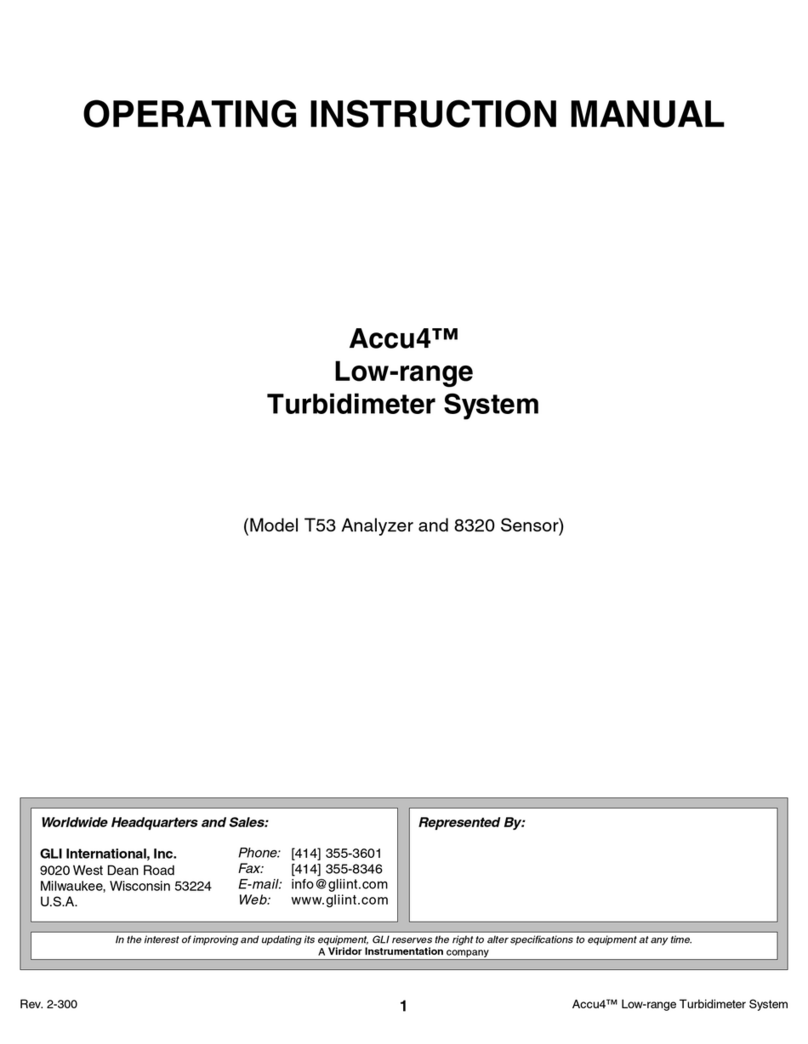
GLI International
GLI International Accu4 Instruction Manual

GLI International
GLI International GLI-98144 User manual

GLI International
GLI International GLI-9143 User manual

GLI International
GLI International P53 Instruction Manual

GLI International
GLI International P33 Instruction Manual
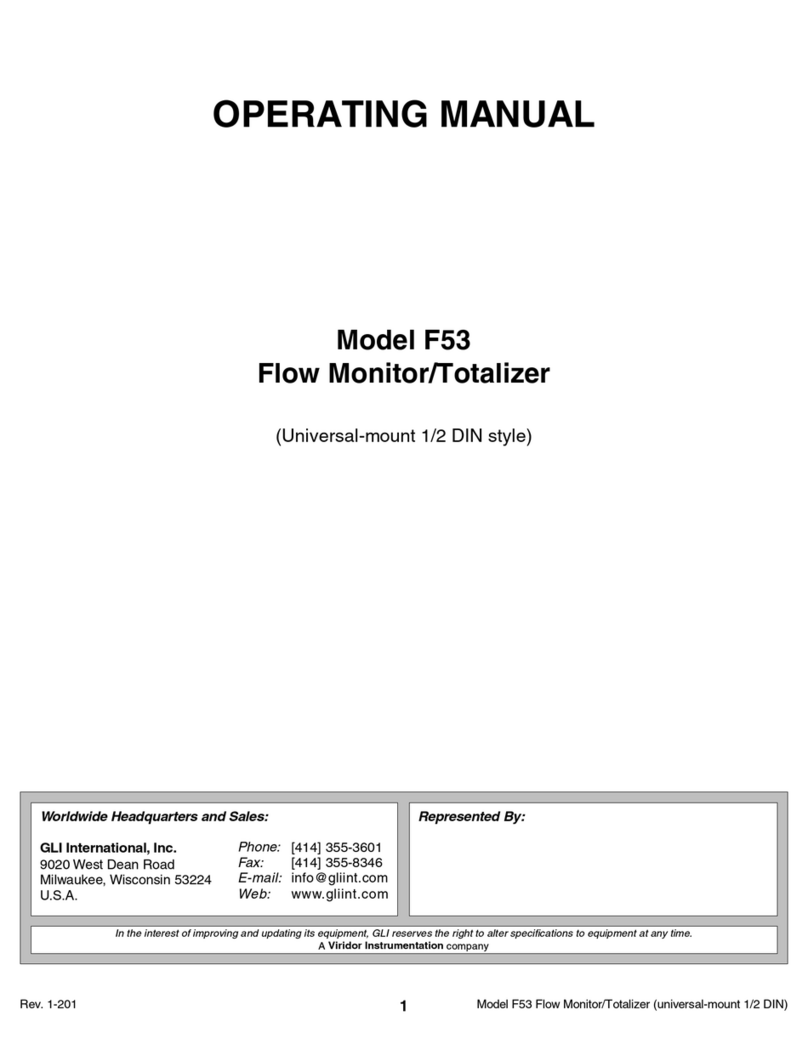
GLI International
GLI International F53 User manual

GLI International
GLI International GLI-93711 User manual
